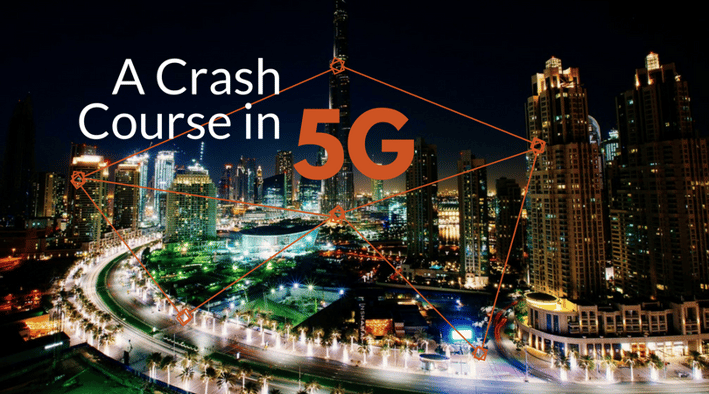
For the first 15 years or so of their existence, cell phones were clunky devices which could only be used to make voice calls - which were frequently dropped.
Remember these GIANT things?? ...The Model T of cell phones, The 1983 Motorola Dynatac:

If you'd like to go on a quick side tangent, check out The Evolution of Cell Phones.
Anyway, these first cell phones were considered first-generation or “1G” phones. Then came 2G, which brought us the wonders of text messaging. 3G was a huge leap forward, making internet access completely mobile, and now most of us living in industrialized nations using 4G phones, which bring us the speed we’ve grown accustomed to.
But as more and more devices make use of the traditional radio frequency spectrum used by mobile devices (3khz-6Ghz), these frequencies are becoming too crowded. The demand placed by more devices on this limited bandwidth is putting a strain on existing 4G networks, causing slower service and sometimes drops in coverage. With emerging technologies like the Internet of Things, driverless vehicles, and more, the spectrum is only going to get more crowded.
So what's the solution?
Enter: 5G Wireless
A few years ago, RF engineers trying to fix this problem had an idea: "If it’s getting too crowded on the currently used frequencies, why not just widen the spectrum a bit, and use frequencies that haven’t been harnessed before?"
This idea is the driving force behind the emergence of 5G.
5G will be the next phase in the evolution of mobile service, and represents the biggest leap forward since 3G, and promises to offer speeds no one previously dreamed possible. This new technology makes use of extremely high frequency (EHF) waves in the 30-300Ghz range, also known as Millimeter Waves.
These frequency ranges will allow for speeds up to 10 times faster than 4G LTE.
Imagine... being able to download a feature length film in just only a few seconds, or a season of your favorite TV show in high definition in under a minute. Harnessing the power of millimeter waves will make all of this possible, but it turns out that there are some unexpected challenges when working with these new higher frequencies.
Taking On 5G Problems
While millimeter waves are the key technology that makes 5G possible, it is much more complicated to build a functional wireless network that uses these shorter wavelengths.
One problem with millimeter waves is that they do not travel very well through buildings and other physical barriers. They also tend to be absorbed by natural phenomena like rain. Obviously, this is unacceptable, so RF engineers had to devise a way around this.
Small Cells
The solution is a new system called small cells. In a traditional wireless network, those huge cell towers you occasionally see while driving on the highway, broadcast their signal outward in every direction, and your phone just picks it up. That’s fine when you’re working in the 6kz-Ghz range, but with millimeter waves, buildings, trees, and the weather will interfere with the signal. Engineers can solve this problem by building smaller base stations called small cells throughout a coverage area. Each small cell station picks up the signal and relays on to the next one, eventually arriving at the connected device.
These base stations can be much smaller than standard cell towers - small enough to place on top of buildings, telephone poles, etc., without visually taking over the landscape. Small cells would be a great fit for urban and suburban environments, as they can be discretely placed about every 250 meters. This is easy enough to do in a city, but this will prove more challenging for covering rural areas.
Massive MIMO
The next key component of making 5G possible is Massive Multiple Input-Multiple Output or “Massive MIMO” technology. The term “MIMO” simply describes a system that uses at least two transmitters and receivers to receive and transmit data. A typical cell base station already uses a 12-port MIMO system, with 8 antennae for transmission and 4 used for receiving.
“Massive” MIMO takes this concept and kicks it up a notch. A Massive MIMO base station can support almost 100 ports, enormously boosting the the capacity of mobile networks, according to the IEEE. One test at the University of Bristol using a 128-antenna array produced an incredible 22-fold increase in spectrum efficiency (the amount of data which can be transmitted to a given number of users per second). (Source)
Beamforming
While this all sounds great, there’s just one problem: with Massive MIMO arrays sending and receiving all those millimeter waves, there is much greater potential for signal interference. Luckily a new technology called Beamforming offers a solution to this.
Both Massive MIMO base stations and standard cell towers broadcast their signals outward in every direction simultaneously. While this is simple, it’s not the most efficient way to transmit a signal and it contributes to the interference mentioned above.
The analogy that is usually used to describe how beamforming works is that of a crossing guard or traffic signaling system for wireless base stations: Beamforming eliminates the inefficiency of omnidirectional transmissions by focusing the millimeter wave signal in the direction of the specific user it is intended for. The technology has actually been in use for a long time in sonar and radar systems, but applying it to 5G mobile networks will reduce signal interference and allows the towers to send and receive more data at once.
Full Duplex Technology
Finally, the last piece of the puzzle is Full Duplex technology. Right now, both cell phones and base stations are designed in such a way that they have to take turns sending and receiving signals on the same frequency. In fact, almost all RF systems in use today still have that one fundamental limitation; they cannot send and receive information at the same time.
A full duplex system is one that allows simultaneous transmission and reception of signals on the same frequency. For many years, RF engineers have dreamed of usable full duplex systems for wireless coverage, as it would literally double the capacity of the network. Full duplex systems are currently in use in certain military applications, but these systems are huge in size and their technology simply isn’t applicable to use in a mobile phone or tablet. The good news is that RF engineers are making great progress is designing newer, smaller full duplex systems that are feasible for use in mobile devices.
5Get with the Future of 5G!
There is no doubt that 5G represents a quantum leap forward for both the field of RF engineering and for consumer expectations for speed and quality of service. The first commercial 5G networks are expected to be operational around 2020, and there’s no doubt that this amazing millimeter wave technology will see use in the space, defense, and aerospace markets as well.
At Bliley, we make it our business to stay ahead of the curve on all industry trends and new developments. To learn more about our advanced RF solutions, send us a quick message and let us know how we can help.






